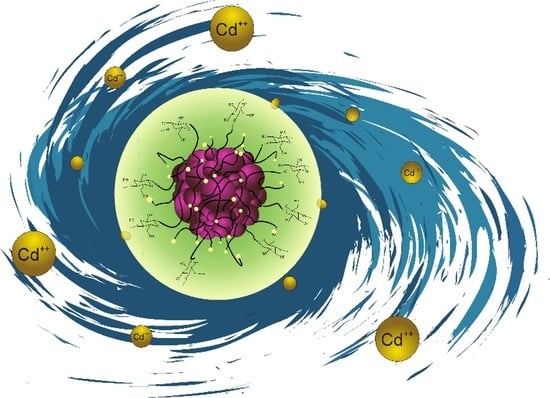Magnetic Solid-Phase Extraction of Cadmium Ions by Hybrid Self-Assembled Multicore Type Nanobeads
Abstract
1. Introduction
2. Materials and Methods
2.1. Reagents
2.2. Preparation of Magnetic Nanobeads
2.3. Characterization of Magnetic Nanobeads
2.4. Adsorption Experiments
2.4.1. Effect of Adsorbent Dosage
2.4.2. Effect of Initial Cd (II) Concentration
2.4.3. Effect of Contact Time
3. Results
3.1. Crystal Structure, Morphology and Magnetic Properties of CF@CMC Magnetic Nanobeads
3.2. Influence of Experimental Parameters on Cd (II) Batch Adsorption Experiments
3.2.1. Effect of Adsorbent Dosage
3.2.2. Effect of Initial Cd (II) Concentration
3.2.3. Effect of Contact Time
3.2.4. Adsorption Isotherms
- A value of 0.04 of point out that the adsorption is favorable.
3.2.5. Kinetic Studies
4. Conclusions
Author Contributions
Funding
Institutional Review Board Statement
Informed Consent Statement
Data Availability Statement
Acknowledgments
Conflicts of Interest
References
- Harja, M.; Ciobanu, G. Ecofriendly nano-adsorbents for pollutant removal from wastewaters. In Handbook of Nanomaterials and Nanocomposites for Energy and Environmental Applications; Kharissova, O., Martínez, L., Kharisov, B., Eds.; Springer: Basel, Switzerland, 2020. [Google Scholar]
- Carolin, C.F.; Kumar, P.S.; Saravanan, A.; Joshiba, G.J.; Naushad, M. Efficient techniques for the removal of toxic heavy metals from aquatic environment: A review. J. Environ. Chem. Eng. 2017, 5, 2782–2799. [Google Scholar] [CrossRef]
- Roman, T.; Asavei, R.L.; Karkalos, N.E.; Roman, C.; Virlan, C.; Cimpoesu, N.; Istrate, B.; Zaharia, M.; Markopoulos, A.P.; Kordatos, K.; et al. Synthesis and adsorption properties of nanocrystalline ferrites for kinetic modeling development. Int. J. Appl. Ceram. Technol. 2019, 16, 693–705. [Google Scholar] [CrossRef]
- Buema, G.; Noli, F.; Misaelides, P.; Sutiman, D.M.; Cretescu, I.; Harja, M. Uranium removal from aqueous solutions by raw and modified thermal power plant ash. J. Radioanal. Nucl. Chem. 2014, 299, 381–386. [Google Scholar] [CrossRef]
- Jorfi, S.; Shooshtarian, M.R.; Pourfadakari, S. Decontamination of cadmium from aqueous solutions using zeolite decorated by Fe3O4 nanoparticles: Adsorption modeling and thermodynamic studies. Int. J. Environ. Sci. Technol. 2020, 17, 273–286. [Google Scholar] [CrossRef]
- Harja, M.; Buema, G.; Lupu, N.; Chiriac, H.; Herea, D.D.; Ciobanu, G. Fly ash coated with magnetic materials with improved adsorption capacities. Materials 2021, 14, 63. [Google Scholar] [CrossRef]
- Abbas, A.; Al-Amer, A.M.; Laoui, T.; Al-Marri, M.J.; Nasser, M.S.; Khraisheh, M.; Atieh, M.A. Heavy metal removal from aqueous solution by advanced carbon nanotubes: Critical review of adsorption applications. Sep. Purif. Technol. 2016, 157, 141–161. [Google Scholar]
- Zhang, W.; An, Y.; Li, S.; Liu, Z.; Chen, Z.; Ren, Y.; Wang, S.; Zhang, X.; Wang, X. Enhanced heavy metal removal from an aqueous environment using an eco-friendly and sustainable adsorbent. Sci. Rep. 2020, 10, 16453. [Google Scholar] [CrossRef]
- Rajczykowski, K.; Loska, K. Stimulation of Heavy Metal Adsorption Process by Using a Strong Magnetic Field. Water Air Soil Pollut. 2018, 229, 20. [Google Scholar] [CrossRef]
- Kokkinos, E.; Chousein, C.; Simeonidis, K.; Coles, S.; Zouboulis, A.; Mitrakas, M. Improvement of manganese feroxyhyte’s surface charge with exchangeable Ca ions to maximize Cd and Pb uptake from water. Materials 2020, 13, 1762. [Google Scholar] [CrossRef]
- Attar, K.; Bouazza, D.; Miloudi, H.; Tayeb, A.; Boos, A.; Sastre, A.M.; Demey, H. Cadmium removal by a low-cost magadiite-based material: Characterization and sorption applications. J. Environ. Chem. Eng. 2018, 6, 5351–5360. [Google Scholar] [CrossRef]
- Pyrzynska, K. Removal of cadmium from wastewaters with low-cost adsorbents. J. Environ. Chem. Eng. 2019, 7, 102795. [Google Scholar] [CrossRef]
- Waalkes, M.P. Cadmium carcinogenesis in review. J. Inorg. Biochem. 2000, 79, 241–244. [Google Scholar] [CrossRef]
- Bernhoft, R.A. Cadmium toxicity and treatment. Sci. World J. 2013, 2013, 394652. [Google Scholar] [CrossRef] [PubMed]
- Mone, M.; Lambropoulou, D.A.; Bikiaris, D.N.; Kyzas, G. Chitosan Grafted with Biobased 5-Hydroxymethyl-Furfural as Adsorbent for Copper and Cadmium Ions Removal. Polymers 2020, 12, 1173. [Google Scholar] [CrossRef] [PubMed]
- Zhao, H.; Huang, X.; Zhang, G.; Li, J.; He, Z.; Ji, P.; Zhao, J. Possibility of removing cadmium pollution from the environment using a newly synthesized material coal fly ash. Environ. Sci. Pollut. Res. 2020, 27, 4997–5008. [Google Scholar] [CrossRef]
- Zhu, C.; Luan, Z.; Wang, Y.; Shan, X. Removal of cadmium from aqueous solutions by adsorption on granular red mud (GRM). Sep. Purif. Technol. 2007, 57, 161–169. [Google Scholar] [CrossRef]
- Ouadjenia-Marouf, F.; Marouf, R.; Schott, J.; Yahiaoui, A. Removal of Cu (II), Cd(II) and Cr(III) ions from aqueous solution by dam silt. Arab. J. Chem. 2013, 6, 401–406. [Google Scholar] [CrossRef]
- Godt, J.; Scheidig, F.; Grosse-Siestrup, C.; Esche, V.; Brandenburg, P.; Reich, A.; Groneberg, D.A. The toxicity of cadmium and resulting hazards for human health. J. Occup. Med. Toxicol. 2006, 1, 1–6. [Google Scholar] [CrossRef]
- Ahmad, R.; Mirza, A. Facile one pot green synthesis of Chitosan-Iron oxide (CS-Fe2O3) nanocomposite: Removal of Pb (II) and Cd (II) from synthetic and industrial wastewater. J. Clean. Prod. 2018, 186, 342–352. [Google Scholar] [CrossRef]
- Anbia, M.; Khoshbooei, S. Functionalized magnetic MCM-48 nanoporous silica by cyanuric chloride for removal of chlorophenol and bromophenol from aqueous media. J. Nanostructure Chem. 2015, 5, 139–146. [Google Scholar] [CrossRef]
- Kang, A.J.; Baghdadi, M.; Pardakhti, A. Removal of cadmium and lead from aqueous solutions by magnetic acid-treated activated carbon nanocomposite. Desalin. Water Treat. 2016, 57, 18782–18798. [Google Scholar] [CrossRef]
- De Castro Alves, L.; Yáñez-Vilar, S.; Piñeiro-Redondo, Y.; Rivas, J. Novel magnetic nanostructured beads for cadmium (II) removal. Nanomaterials 2019, 9, 356. [Google Scholar] [CrossRef] [PubMed]
- Park, C.M.; Kim, Y.M.; Kim, K.H.; Wang, D.; Su, C.; Yoon, Y. Potential utility of graphene-based nano spinel ferrites as adsorbent and photocatalyst for removing organic/inorganic contaminants from aqueous solutions: A mini review. Chemosphere 2019, 221, 392–402. [Google Scholar] [CrossRef] [PubMed]
- Liu, F.; Zhou, K.; Chen, Q.; Wang, A.; Chen, W. Comparative study on the synthesis of magnetic ferrite adsorbent for the removal of Cd (II) from wastewater. Adsorpt. Sci. Technol. 2018, 36, 1456–1469. [Google Scholar] [CrossRef]
- Tian, Y.; Gao, B.; Morales, V.L.; Wu, L.; Wang, Y.; Muñoz-Carpena, R.; Yang, L. Methods of using carbon nanotubes as filter media to remove aqueous heavy metals. Chem. Eng. J. 2012, 210, 557–563. [Google Scholar] [CrossRef]
- Ray, P.Z.; Shipley, H.J. Inorganic nano-adsorbents for the removal of heavy metals and arsenic: A review. RSC Adv. 2015, 5, 29885–29907. [Google Scholar] [CrossRef]
- Hashmi, M.; Ullah, S.; Ullah, A.; Akmal, M.; Saito, Y.; Hussain, N.; Ren, X.; Kim, I.S. Optimized Loading of Carboxymethyl Cellulose (CMC) in Tri-component Electrospun Nanofibers Having Uniform Morphology. Polymers 2020, 12, 2524. [Google Scholar] [CrossRef]
- Vunain, E.; Mishra, A.K.; Mamba, B.B. Dendrimers, mesoporous silicas and chitosan-based nanosorbents for the removal of heavy-metal ions: A review. Int. J. Biol. Macromol. 2016, 86, 570–586. [Google Scholar] [CrossRef]
- Elwakeel, K.Z.; Al-Bogami, A.S. Influence of Mo (VI) immobilization and temperature on As (V) sorption onto magnetic separable poly p-phenylenediamine-thiourea-formaldehyde polymer. J. Hazard. Mater. 2018, 342, 335–346. [Google Scholar] [CrossRef]
- Zhou, J.; Liu, Y.; Zhou, X.; Ren, J.; Zhong, C. Magnetic multi-porous bio-adsorbent modified with amino siloxane for fast removal of Pb (II) from aqueous solution. Appl. Surf. Sci. 2018, 427, 976–985. [Google Scholar] [CrossRef]
- Wang, S.; Zhang, C.; Chang, Q. Synthesis of magnetic crosslinked starch-graft-poly (acrylamide)-co-sodium xanthate and its application in removing heavy metal ions. J. Exp. Nanosci. 2017, 12, 270–284. [Google Scholar] [CrossRef]
- Ahamad, T.; Naushad, M.; Ubaidullah, M.; Alshehri, S. Fabrication of Highly Porous Polymeric Nanocomposite for the Removal of Radioactive U (VI) and Eu (III) Ions from Aqueous Solution. Polymers 2020, 12, 2940. [Google Scholar] [CrossRef] [PubMed]
- López-Ortega, A.; Lottini, E.; Fernandez, C.D.J.; Sangregorio, C. Exploring the magnetic properties of cobalt-ferrite nanoparticles for the development of a rare-earth-free permanent magnet. Chem. Mater. 2015, 27, 4048–4056. [Google Scholar] [CrossRef]
- Maaz, K.; Mumtaz, A.; Hasanain, S.K.; Ceylan, A. Synthesis and magnetic properties of cobalt ferrite (CoFe2O4) nanoparticles prepared by wet chemical route. J. Magn. Magn. Mater. 2007, 308, 289–295. [Google Scholar] [CrossRef]
- Cedeño-Mattei, Y.; Perales-Pérez, O. Synthesis of high-coercivity cobalt ferrite nanocrystals. Microelectron. J. 2009, 40, 673–676. [Google Scholar] [CrossRef]
- Chen, D.; Yi, X.; Chen, Z.; Zhang, Y.; Chen, B.; Kang, Z. Synthesis of CoFe2O4 Nanoparticles by a Low Temperature Microwave-Assisted Ball-Milling Technique. Int. J. Appl. Ceram. Technol. 2014, 11, 954–959. [Google Scholar] [CrossRef]
- Shafi, K.V.; Gedanken, A.; Prozorov, R.; Balogh, J. Sonochemical preparation and size-dependent properties of nanostructured CoFe2O4 particles. Chem. Mater. 1998, 10, 3445–3450. [Google Scholar] [CrossRef]
- Ding, J.; McCormick, P.G.; Street, R. Magnetic properties of mechanically alloyed CoFe2O4. Solid State Commun. 1995, 95, 31–33. [Google Scholar] [CrossRef]
- Cui, H.; Jia, Y.; Ren, W.; Wang, W. Facile and ultra large scale synthesis of nearly monodispersed CoFe2O4 nanoparticles by a low temperature sol–gel route. J. Sol-Gel Sci. Technol. 2010, 55, 36–40. [Google Scholar] [CrossRef]
- Gandha, K.; Elkins, K.; Poudyal, N.; Liu, J.P. Synthesis and characterization of CoFe2O4 nanoparticles with high coercivity. J. Appl. Phys. 2015, 117, 17A736. [Google Scholar] [CrossRef]
- Ferreira, L.P.; Cruz, M.M.; Oliveira, M.L.; Mendo, S.G.; Alves, A.F.; Godinho, M.; Carvalho, M.D. CoFe2O4 nanoparticles synthesized with natural templates. RSC Adv. 2016, 6, 73506–73516. [Google Scholar] [CrossRef]
- Hasegawa, K.I.; Satō, T. Particle-Size Distribution of CoFe2O4 Formed by the Coprecipitation Method. J. Appl. Phys. 1967, 38, 4707–4713. [Google Scholar] [CrossRef]
- Sato, T. Formation and magnetic properties of ultrafine spinel ferrites. IEEE Trans. Magn. 1970, 6, 795–799. [Google Scholar] [CrossRef]
- Sugimoto, T.; Matijević, E. Formation of uniform spherical magnetite particles by crystallization from ferrous hydroxide gels. J. Colloid Interface Sci. 1980, 74, 227–243. [Google Scholar] [CrossRef]
- Kunda, W.; Rudyk, B. Aqueous reduction of sulphur dioxide by pyrrhotite to elemental sulphur. Can. Metall. Q. 1970, 9, 551–561. [Google Scholar] [CrossRef]
- Gotic, M.; Czako-Nagy, I.; Popovic, S.; Music, S. Formation of nanocrystalline NiFe2O4. Philos. Mag. Lett. 1998, 78, 193–201. [Google Scholar] [CrossRef]
- Li, X.; Lu, G.; Li, S. Synthesis and characterization of fine particle ZnFe2O4 powders by a low temperature method. J. Alloys Compd. 1996, 235, 150–155. [Google Scholar] [CrossRef]
- Lopez, F.A.; Lopez-Delgado, A.; de Vidales, J.M.; Vila, E. Synthesis of nanocrystalline zinc ferrite powders from sulphuric pickling waste water. J. Alloys Compd. 1998, 265, 291–296. [Google Scholar] [CrossRef]
- Okuda, T. Removal of heavy metals from wastewater by ferrite co-precipitation. Filtr. Sep. 1975, 472–476. [Google Scholar]
- Tamaura, Y.; Katsura, T.; Rojarayanont, S.; Yoshida, T.; Abe, H. Ferrite process; Heavy metal ions treatment system. Water Sci. Technol. 1991, 23, 1893–1900. [Google Scholar] [CrossRef]
- Shokrollahi, H.; Avazpour, L. Influence of intrinsic parameters on the particle size of magnetic spinel nanoparticles synthesized by wet chemical methods. Particuology 2016, 26, 32–39. [Google Scholar] [CrossRef]
- Yadav, R.S.; Havlica, J.; Masilko, J.; Kalina, L.; Hajdúchová, M.; Enev, V.; Wasserbauer, J.; Kuvritka, I.; Kozakova, Z. Structural, Cation Distribution, and Magnetic Properties of CoFe2O4 Spinel Ferrite Nanoparticles Synthesized Using a Starch-Assisted Sol–Gel Auto-Combustion Method. J. Supercond. Nov. Magn. 2015, 28, 1851–1861. [Google Scholar] [CrossRef]
- Deraz, N.M.; Alarifi, A. Controlled synthesis, physicochemical and magnetic properties of nano-crystalline Mn ferrite system. Int. J. Electrochem. Sci. 2012, 7, 5534–5543. [Google Scholar]
- Veverka, M.; Veverka, P.; Kaman, O.; Lančok, A.; Závěta, K.; Pollert, E.; Knížek, K.; Boháček, J.; Beneš, M.; Kašpar, P.; et al. Magnetic heating by cobalt ferrite nanoparticles. Nanotechnology 2007, 18, 345704. [Google Scholar] [CrossRef]
- Carp, O.; Patron, L.; Reller, A. Coordination compounds containing urea as precursors for oxides—A new route of obtaining nanosized CoFe2O4. Mater. Chem. Phys. 2007, 101, 142–147. [Google Scholar] [CrossRef]
- Pui, A.; Gherca, D.; Cornei, N. Synthesis and characterization of MFe2O4 (M = Mg, Mn, Ni) nanoparticles. Mater. Res. Bull. 2013, 48, 1357–1362. [Google Scholar] [CrossRef]
- Fullprof, C.J. A program for Rietveld refinement and pattern matching analysis. In Satellite Meeting on Powder Diffraction of the XV Congress of the IUCr (Toulouse, France); 1990; Volume 127. [Google Scholar]
- Thompson, P.; Cox, D.E.; Hastings, J.B. Rietveld refinement of Debye–Scherrer synchrotron X-ray data from Al2O3. J. Appl. Crystallogr. 1987, 20, 79–83. [Google Scholar] [CrossRef]
- Naik, S.R.; Salker, A.V. Change in the magnetostructural properties of rare earth doped cobalt ferrites relative to the magnetic anisotropy. J. Mat. Chem. 2012, 22, 2740–2750. [Google Scholar] [CrossRef]
- Kumar, Y.; Shirage, P.M. Highest coercivity and considerable saturation magnetization of CoFe2O4 nanoparticles with tunable band gap prepared by thermal decomposition approach. J. Mater. Sci. 2017, 52, 4840–4851. [Google Scholar] [CrossRef]
- Limaye, M.V.; Singh, S.B.; Date, S.K.; Kothari, D.; Reddy, V.R.; Gupta, A.; Sathe, V.; Choudhary, R.J.; Kulkarni, S.K. High coercivity of oleic acid capped CoFe2O4 nanoparticles at room temperature. J. Phys. Chem. B 2009, 113, 9070–9076. [Google Scholar] [CrossRef]
- Chinnasamy, C.N.; Jeyadevan, B.; Shinoda, K.; Tohji, K.; Djayaprawira, D.J.; Takahashi, M.; Narayanasamy, A. Unusually high coercivity and critical single-domain size of nearly monodispersed CoFe2O4 nanoparticles. Appl. Phys. Lett. 2003, 83, 2862–2864. [Google Scholar] [CrossRef]
- Smolensky, E.D.; Park, H.Y.E.; Zhou, Y.; Rolla, G.A.; Marjańska, M.; Botta, M.; Pierre, V.C. Scaling laws at the nanosize: The effect of particle size and shape on the magnetism and relaxivity of iron oxide nanoparticle contrast agents. J. Mater. Chem. B 2013, 1, 2818–2828. [Google Scholar] [CrossRef] [PubMed]
- Liu, F.; Laurent, S.; Roch, A.; Elst, L.V.; Muller, R.N. Size-controlled synthesis of CoFe2O4 nanoparticles potential contrast agent for MRI and investigation on their size-dependent magnetic properties. J. Nanomat. 2013, 2013, 1–9. [Google Scholar]
- Berkowitz, A.E.; Lahut, J.A.; Jacobs, I.S.; Levinson, L.M.; Forester, D.W. Spin pinning at ferrite-organic interfaces. Phys. Rev. Lett. 1975, 34, 594–597. [Google Scholar] [CrossRef]
- Wang, C.C.; Lee, C.K.; Lyu, M.D.; Juang, L.C. Photocatalytic degradation of CI Basic Violet 10 using TiO2 catalysts supported by Y zeolite: An investigation of the effects of operational parameters. Dye. Pigment. 2008, 76, 817–824. [Google Scholar] [CrossRef]
- Meroufel, B.; Benali, O.; Benyahia, M.; Benmoussa, Y.; Zenasni, M.A. Adsorptive removal of anionic dye from aqueous solutions by Algerian kaolin: Characteristics, isotherm, kinetic and thermodynamic studies. J. Mater. Environ. Sci. 2013, 4, 482–491. [Google Scholar]
- Buema, G.; Lupu, N.; Chiriac, H.; Roman, T.; Porcescu, M.; Ciobanu, G.; Burghila, D.V.; Harja, M. Eco-Friendly Materials Obtained by Fly Ash Sulphuric Activation for Cadmium Ions Removal. Materials 2020, 13, 3584. [Google Scholar] [CrossRef] [PubMed]
- Badruddoza, Z.M.; Shawon, Z.B.Z.; Tay, W.J.D.; Hidajat, K.; Uddin, M.S. Fe3O4/cyclodextrin polymer nanocomposites for selective heavy metals removal from industrial wastewater. Carbohydr. Polym. 2013, 91, 322–332. [Google Scholar] [CrossRef]
- Hua, R.; Li, Z. Sulfhydryl functionalized hydrogel with magnetism: Synthesis, characterization, and adsorption behavior study for heavy metal removal. Chem. Eng. J. 2014, 249, 189–200. [Google Scholar] [CrossRef]
- Guo, X.; Du, B.; Wei, Q.; Yang, J.; Hu, L.; Yan, L.; Xu, W. Synthesis of amino functionalized magnetic graphenes composite material and its application to remove Cr(VI), Pb(II), Hg(II), Cd(II) and Ni(II) from contaminated water. J. Hazard. Mater. 2014, 278, 211–220. [Google Scholar] [CrossRef]
- Venkateswarlu, S.; Yoon, M. Rapid removal of cadmium ions using green synthesized Fe3O4 nanoparticles capped with diethyl-4-(4 amino-5-mercapto-4H-1,2,4-triazol3-yl)phenyl phosphonate. RSC Adv. 2015, 5, 65444. [Google Scholar] [CrossRef]
- Fallahi, M.R.; Khayatian, G.; Rostami, A.; Pourshiani, O. Guanidine-functionalized magnetic Fe3O4 nanoparticles as a new sorbent for preconcentration of heavy metal ions in water samples. Dig. J. Nanomater. Biostructures 2016, 11, 853–863. [Google Scholar]
- Chen, D.; Awut, T.; Liu, B.; Ma, Y.; Wang, T.; Nurulla, I. Functionalized magnetic Fe3O4 nanoparticles for removal of heavy metal ions from aqueous solutions. e-Polymers 2016, 16, 313–322. [Google Scholar] [CrossRef]
- Jiang, X.; Zhao, Y.; Wang, X.; Liu, L.; Wang, Y.; Zhang, W.; Jiao, L.; Liang, W. Adsorption of aqueous Cd(II) over a Fe3O4/plant polyphenol magnetic material. J. Water Supply Res. Technol. 2018, 67, 738–753. [Google Scholar] [CrossRef]

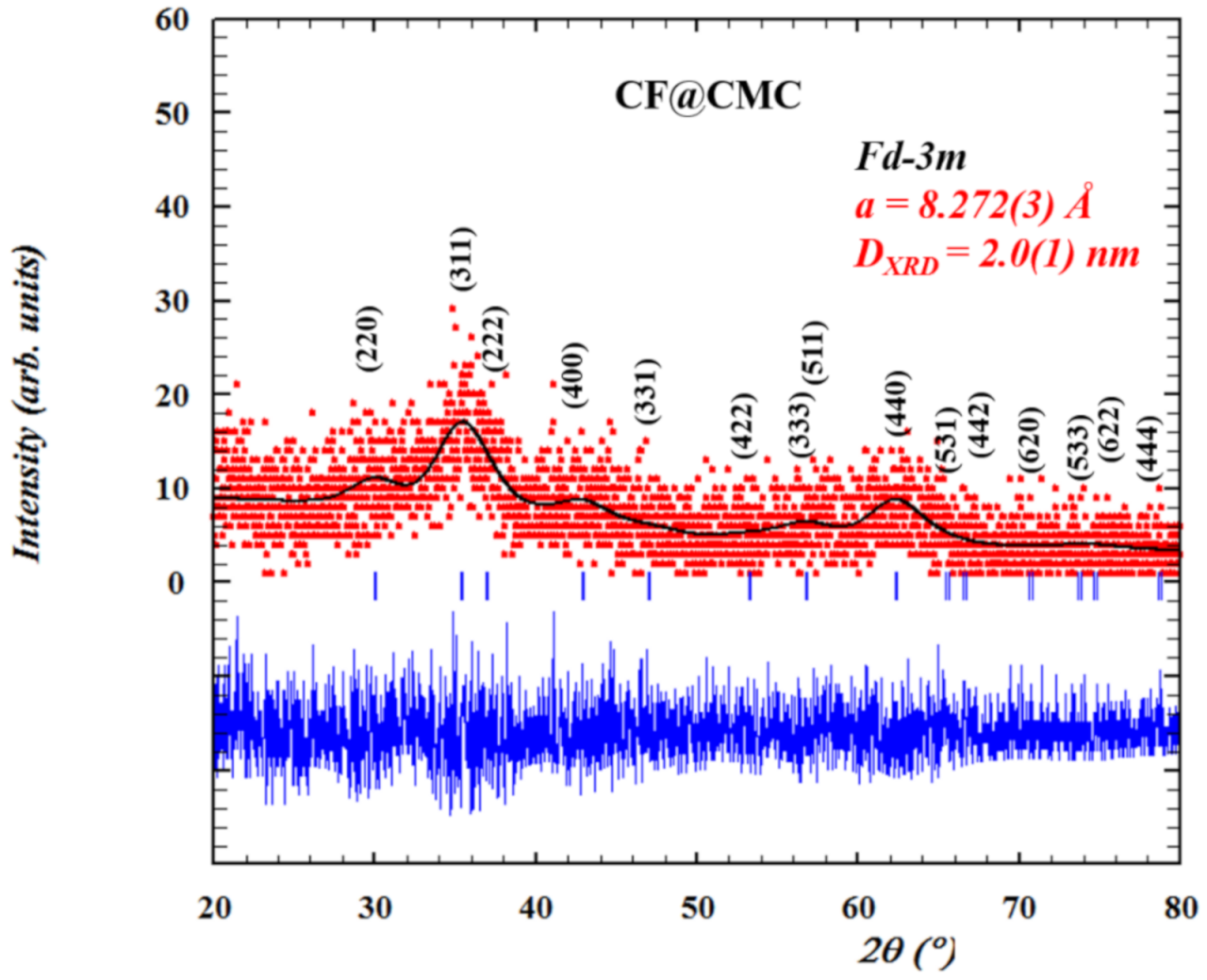
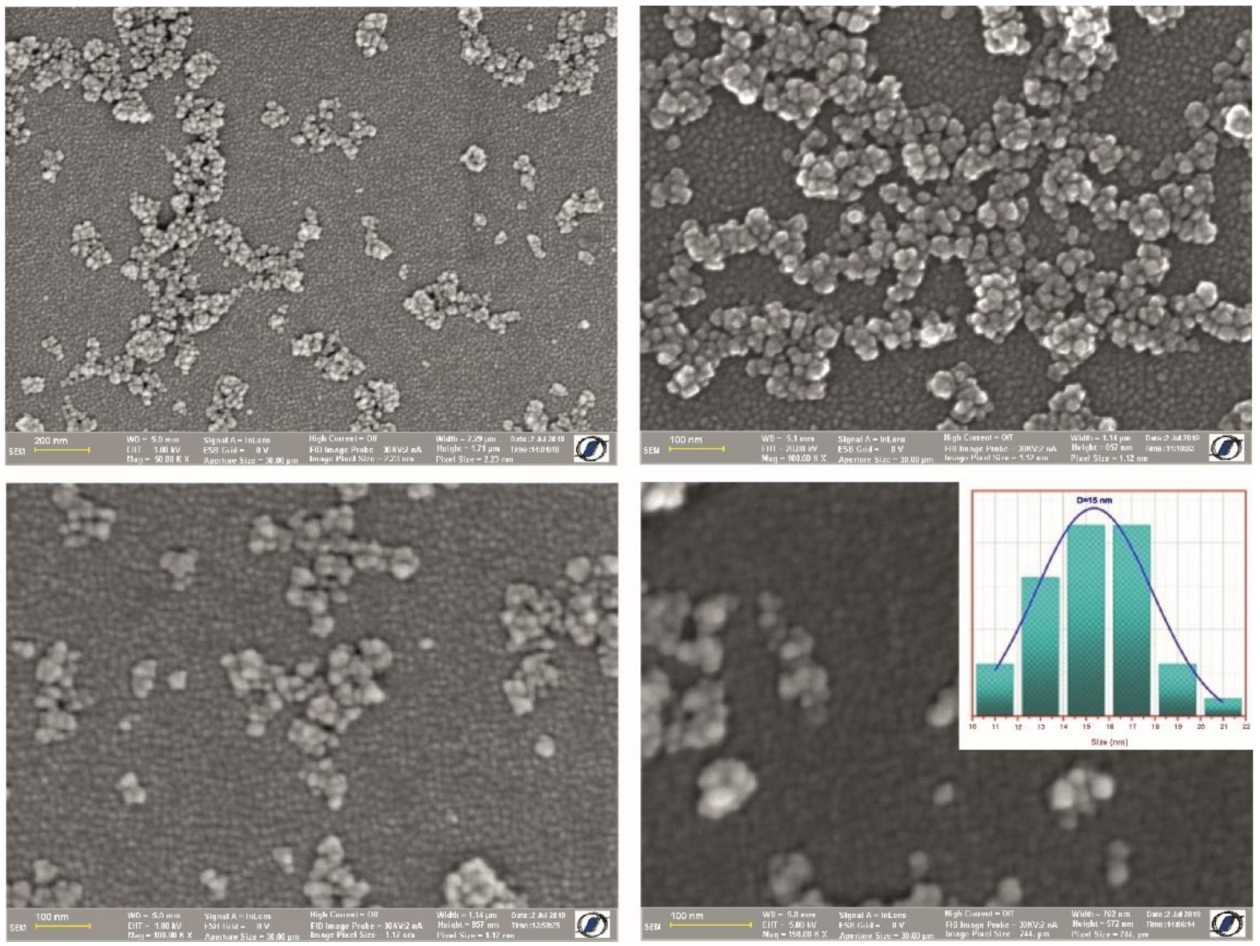
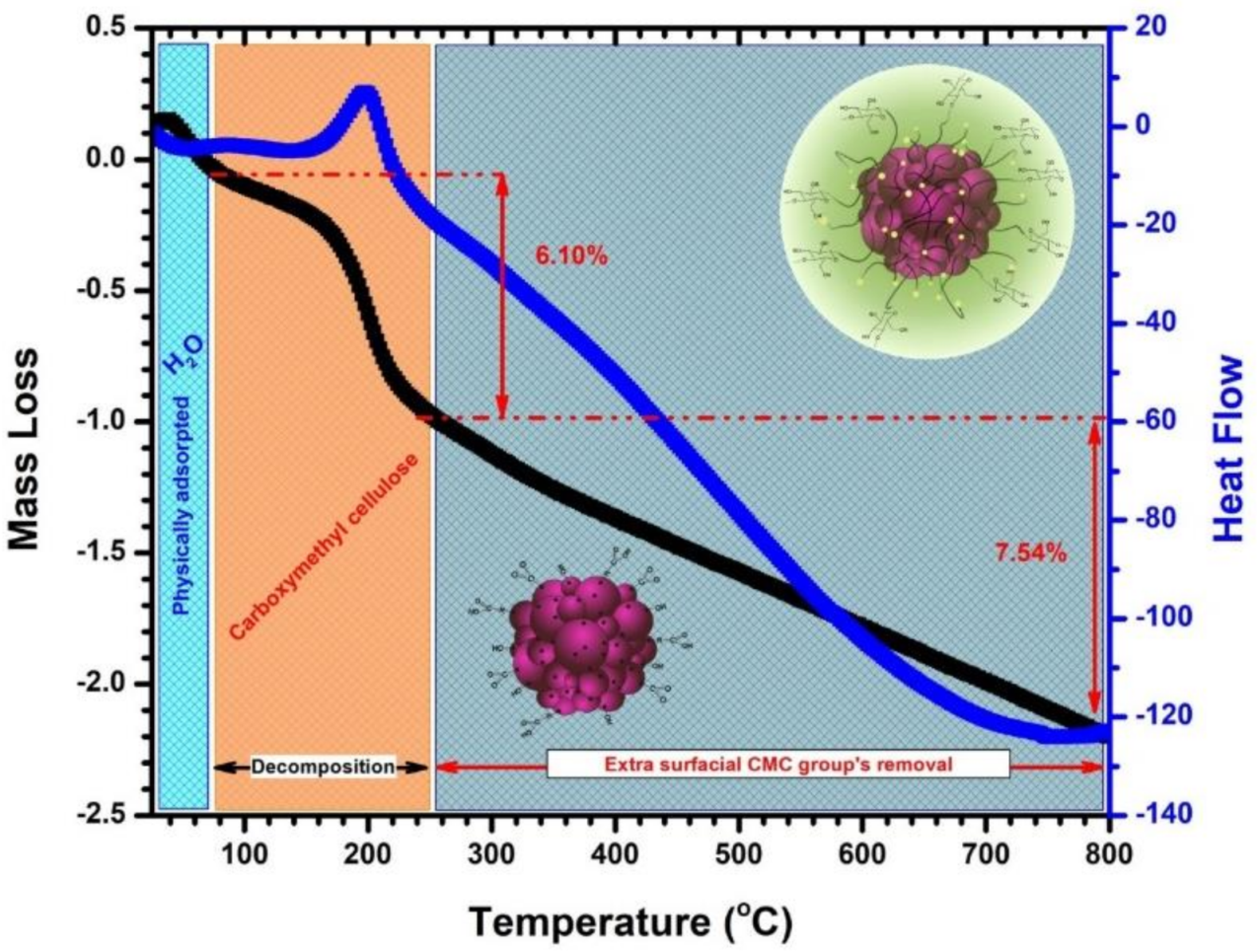
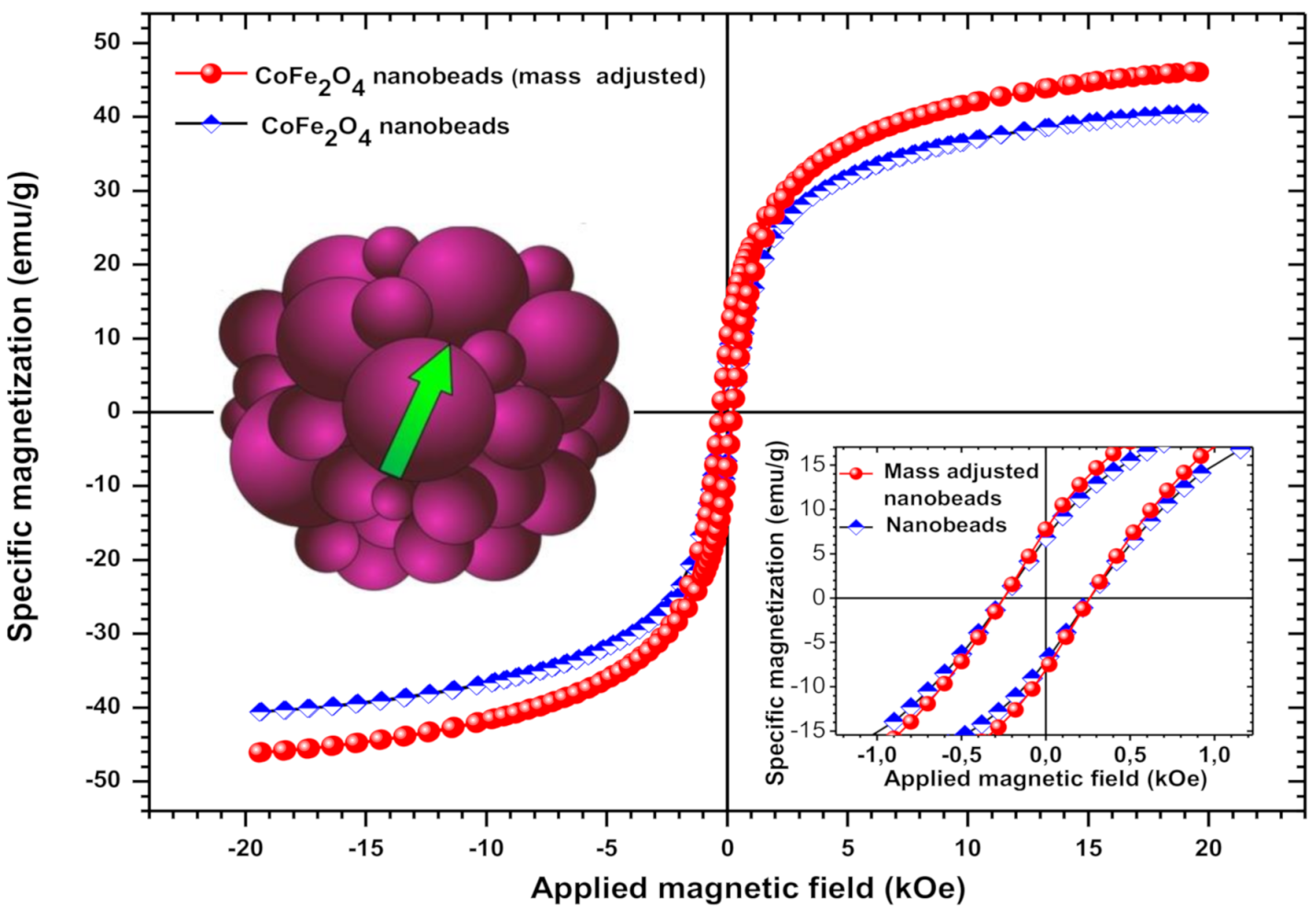
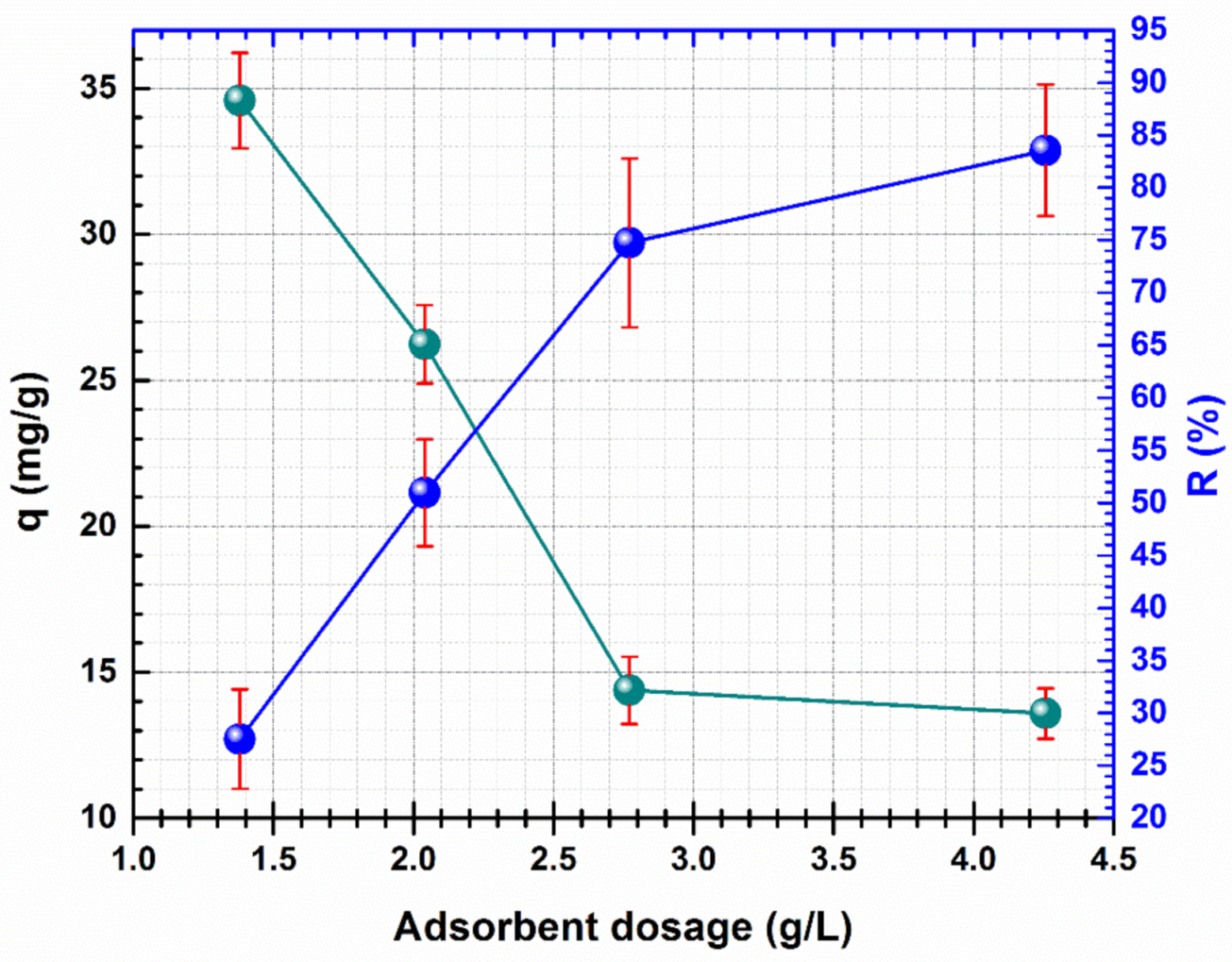
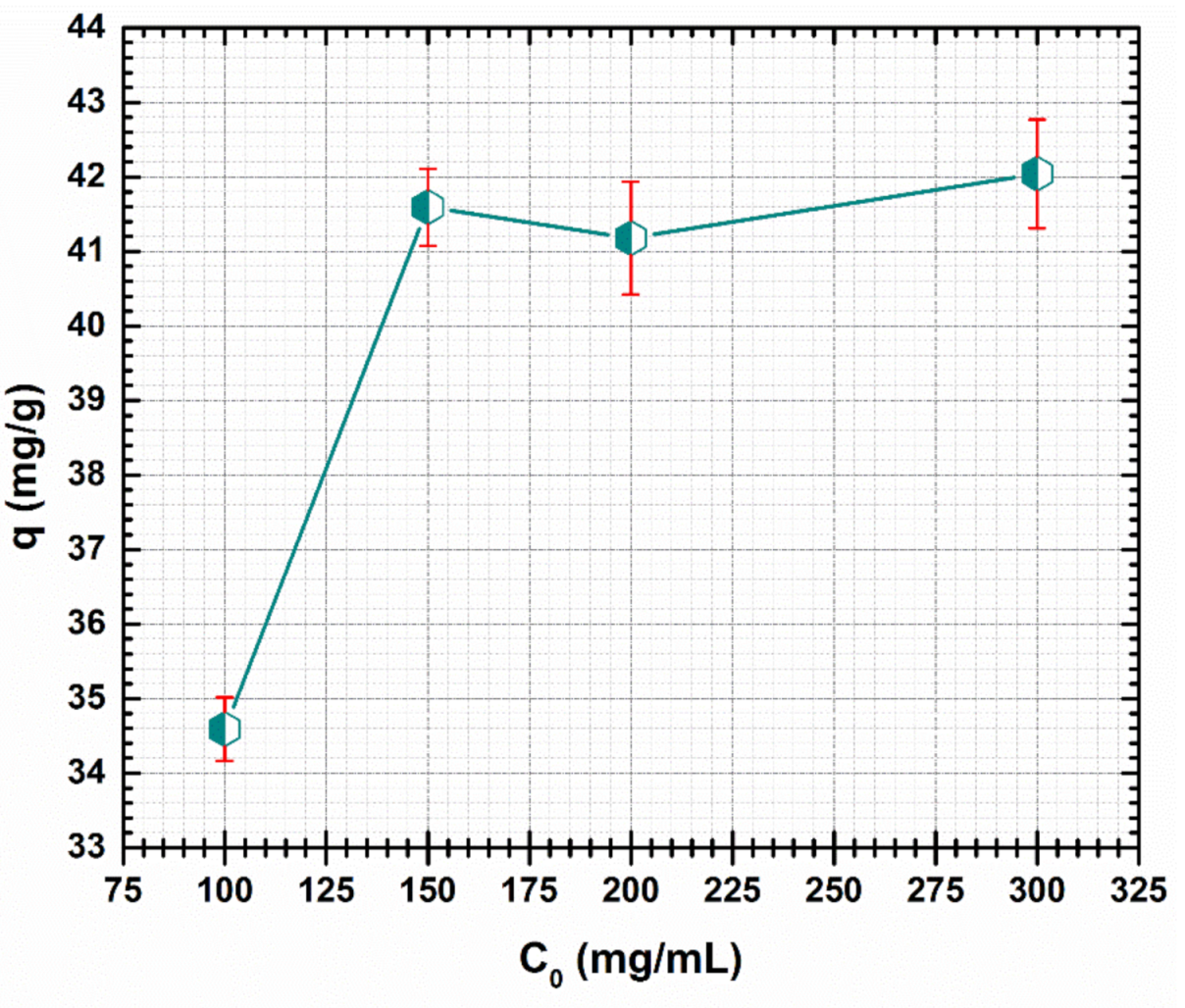
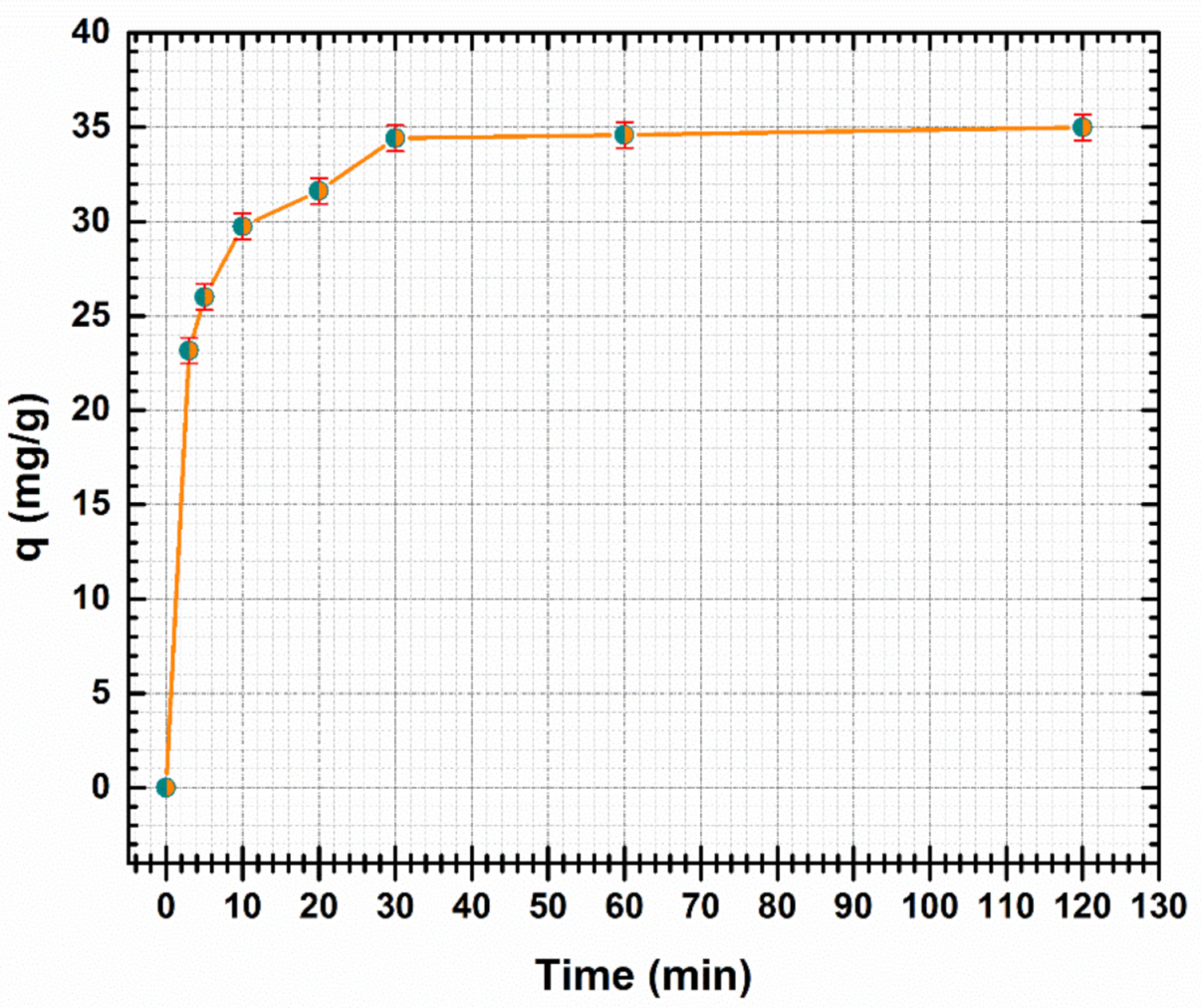
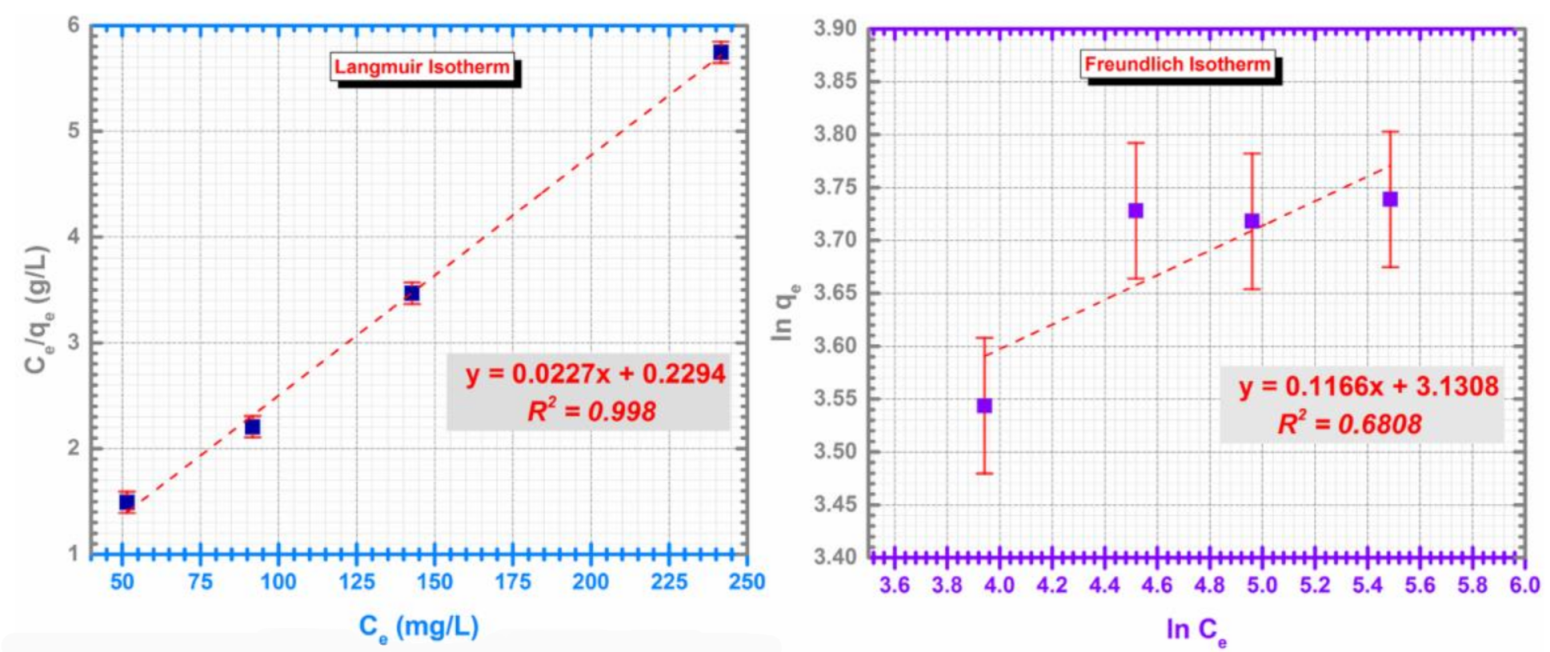
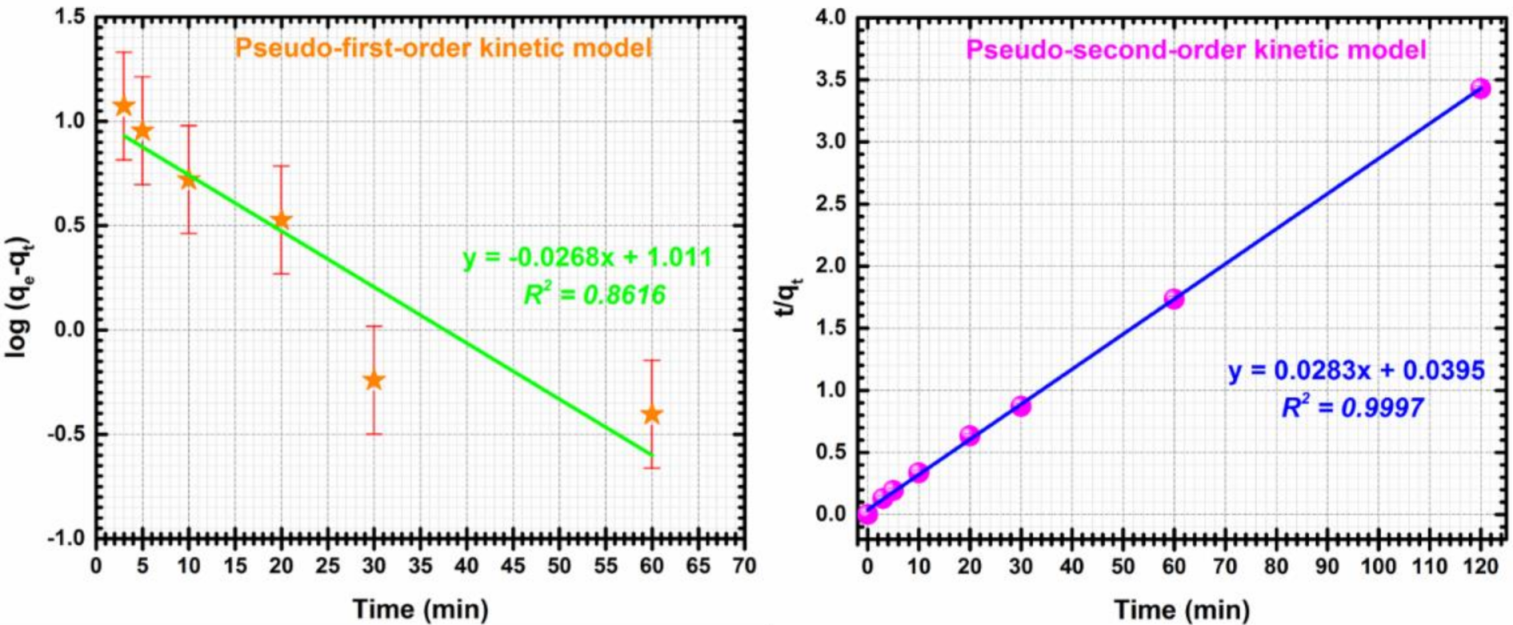
| Langmuir | Freundlich | ||||
|---|---|---|---|---|---|
| qmax, mg/g | , L/g | R2 | , (mg/g)/(L/mg) | 1/n | R2 |
| 44.05 | 0.099 | 0.998 | 22.89 | 0.1166 | 0.6808 |
| Adsorbent | Capacity Uptake, mg/g | References |
|---|---|---|
| CF@CMC | 44.05 | This work |
| Fe3O4/cyclodextrin polymer nanocomposites (Fe3O4–cyclodextrin) | 22.7 | [70] |
| Sulfhydryl functionalized hydrogel with magnetism (Fe3O4–P(Cys/HEA) hydrogel) | 19.5 | [71] |
| Amino functionalized magnetic graphenes composite (Fe3O4–GS) | 27.8 | [72] |
| Fe3O4 nanoparticles capped with diethyl-4-(4 amino-5-mercapto-4H-1,2,4-triazol3-yl)phenyl phosphonate (DEAMTPP@Fe3O4 MNP) | 49.1 | [73] |
| Guanidine-functionalized magnetic Fe3O4 nanoparticles (MNPs-Guanidine) | 13.6 | [74] |
| Functionalized magnetic Fe3O4 nanoparticles (Fe3O4@SiO2-NH-py0) | 45 | [75] |
| Fe3O4/plant polyphenol magnetic material (Fe3O4/PP) | 0.951 | [76] |
Publisher’s Note: MDPI stays neutral with regard to jurisdictional claims in published maps and institutional affiliations. |
© 2021 by the authors. Licensee MDPI, Basel, Switzerland. This article is an open access article distributed under the terms and conditions of the Creative Commons Attribution (CC BY) license (http://creativecommons.org/licenses/by/4.0/).
Share and Cite
Buema, G.; Borhan, A.I.; Herea, D.D.; Stoian, G.; Chiriac, H.; Lupu, N.; Roman, T.; Pui, A.; Harja, M.; Gherca, D. Magnetic Solid-Phase Extraction of Cadmium Ions by Hybrid Self-Assembled Multicore Type Nanobeads. Polymers 2021, 13, 229. https://doi.org/10.3390/polym13020229
Buema G, Borhan AI, Herea DD, Stoian G, Chiriac H, Lupu N, Roman T, Pui A, Harja M, Gherca D. Magnetic Solid-Phase Extraction of Cadmium Ions by Hybrid Self-Assembled Multicore Type Nanobeads. Polymers. 2021; 13(2):229. https://doi.org/10.3390/polym13020229
Chicago/Turabian StyleBuema, Gabriela, Adrian Iulian Borhan, Daniel Dumitru Herea, George Stoian, Horia Chiriac, Nicoleta Lupu, Tiberiu Roman, Aurel Pui, Maria Harja, and Daniel Gherca. 2021. "Magnetic Solid-Phase Extraction of Cadmium Ions by Hybrid Self-Assembled Multicore Type Nanobeads" Polymers 13, no. 2: 229. https://doi.org/10.3390/polym13020229
APA StyleBuema, G., Borhan, A. I., Herea, D. D., Stoian, G., Chiriac, H., Lupu, N., Roman, T., Pui, A., Harja, M., & Gherca, D. (2021). Magnetic Solid-Phase Extraction of Cadmium Ions by Hybrid Self-Assembled Multicore Type Nanobeads. Polymers, 13(2), 229. https://doi.org/10.3390/polym13020229








